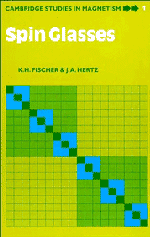Book contents
- Frontmatter
- Contents
- Preface
- 1 Introduction
- 2 Models, order parameters, and systems
- 3 Mean field theory I: Ising model, equilibrium theory
- 4 Introduction to dynamics
- 5 Mean field theory II: Ising dynamics
- 6 Mean field theory III: vector spins
- 7 Short-range interactions: low-temperature properties
- 8 Beyond mean field theory
- 9 Dynamics on many time scales
- 10 Specific heat, sound propagation, and transport properties
- 11 Competition between spin glass and ferromagnetic or antiferromagnetic order
- 12 One-dimensional models
- 13 Random field and random anisotropy
- 14 The physics of complexity
- 15 A short history of spin glasses
- References
- Index
11 - Competition between spin glass and ferromagnetic or antiferromagnetic order
Published online by Cambridge University Press: 01 June 2011
- Frontmatter
- Contents
- Preface
- 1 Introduction
- 2 Models, order parameters, and systems
- 3 Mean field theory I: Ising model, equilibrium theory
- 4 Introduction to dynamics
- 5 Mean field theory II: Ising dynamics
- 6 Mean field theory III: vector spins
- 7 Short-range interactions: low-temperature properties
- 8 Beyond mean field theory
- 9 Dynamics on many time scales
- 10 Specific heat, sound propagation, and transport properties
- 11 Competition between spin glass and ferromagnetic or antiferromagnetic order
- 12 One-dimensional models
- 13 Random field and random anisotropy
- 14 The physics of complexity
- 15 A short history of spin glasses
- References
- Index
Summary
The spin-glass properties discussed so far are observed only in a restricted concentration range of the magnetic atoms. Very dilute metallic magnetic alloys exhibit the Kondo effect (see Section 10.3) and very dilute insulating systems with short-range exchange interactions like EuxSr1−xS with x ≤ 0.13 remain superparamagnetic at all temperatures. In the opposite limit of large concentrations, one has magnetic order. However, there is an interesting concentration range in which one observes a competition between spin-glass and ferro- or antiferromagnetic long range order. This is the subject of this chapter. We will be particularly interested in whether a system which has made a paramagnetic to ferro- or antiferromagnetic transition will go into a ‘reentrant’ spin glass state at some lower temperature or whether there is a coexistence of spin-glass and conventional magnetic order.
Mean field theory
The first hint of an answer to this question comes from MFT. The SK model for Ising spins with the Gaussian bond distribution (3.29), as discussed in Section 3.3, predicts the phase diagram of Fig. 3.7. If the width J of the bond distribution is smaller than the variance J0, one has a spin glass state without spontaneous magnetization Ms. For J0 > J, the system goes with decreasing temperature first into a ferromagnetic state with finite order parameters Ms and q and at a lower temperature into a spin glass state with replica symmetry breaking. In this state, the order parameter q has to be replaced by the Parisi order parameter function q(x) (Section 3.4), whereas the spontaneous magnetization Ms remains finite.
- Type
- Chapter
- Information
- Spin Glasses , pp. 319 - 326Publisher: Cambridge University PressPrint publication year: 1991
- 1
- Cited by



